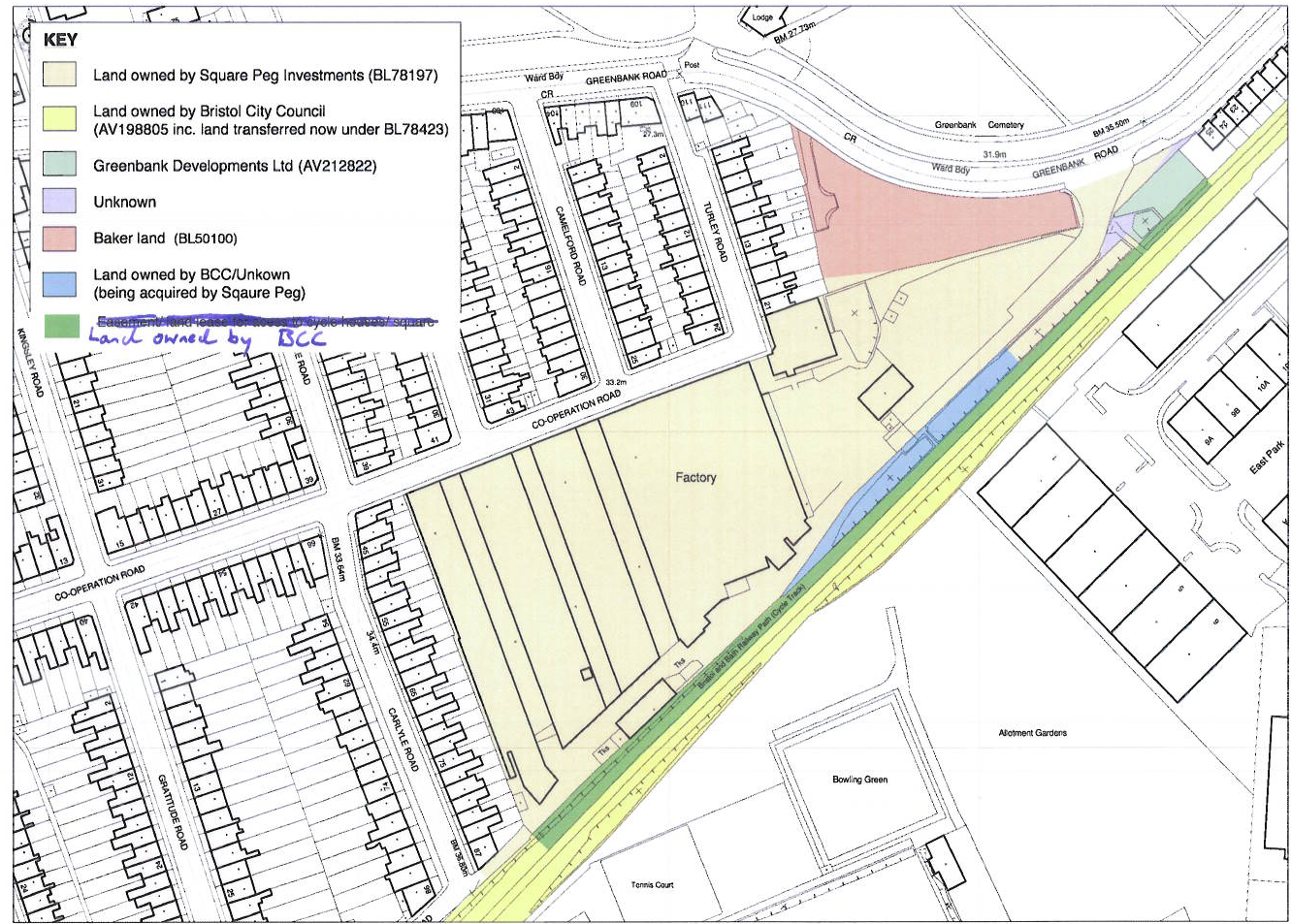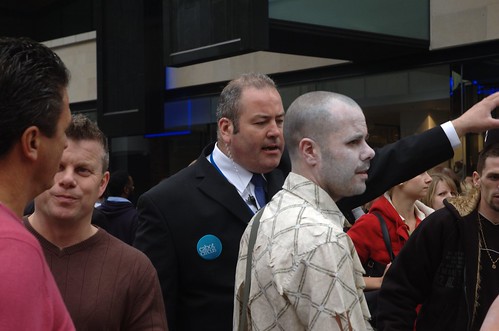From time to time the curious blogger
stumbles across some mysterious object buried in the shifting sands of bureaucratic verbiage. On poking and prodding a little the object slowly reveals itself, only to turn out to be a landmine that proceeds to blow up in the poor blogger's face.
At least that's how it feels today. This morning I decided that enough was known to register some formal objections about the land sell-off discussed in previous
posts. So I sent this email to Bristol City Council.
Sale of Railway Path land, Greenbank
Further to enquiries made last week, I would like to register my concerns about the planned sale of Railway Path land at Greenbank, Bristol, in connection with the proposed development of the former chocolate factory. Having visited the site and discussed the matter with other concerned people, I feel that I must register an objection to the sale of this land to Squarepeg for the following reasons.
1. The land being sold forms an intrinsic part of the green corridor of the Railway Path. It is mainly the slope of the embankment on which the former railway was supported. Such structures are an integral part of the former railway and it now supports a continuous wall of mature vegetation, rising to over 5 metres above the Railway Path. The rural ambiance of the Railway Path, which is so highly valued by the majority of users and local residents, depends on such mature growth on the slopes of embankments and cuttings as well as that on the level margins of the Path
2. There does not appear to have been any consultation on whether the land should be sold. The City Council have apparently taken the view that they are not required to consult. This may be technically correct, but given the controversies that have arisen in relation to most previous attempts to develop elements of the Railway Path it would, I suggest, be prudent to consult before a final decision is taken.
3. Squarepeg, far from consulting on the planned sale, have stated in their Newsletter dated 1st July that the sale had already been completed (or words to that effect) when in fact the sale has not been concluded, so presenting the public with a fait accompli and preempting opportunities for objections to be made. I believe that this may be in breach of their responsibilities in this matter. Again in order to remedy this defect a period of consultation is required before the sale is finalised.
4. The proposed development of the sale land will include a substantial twin-tower block of, I believe, 7 or 8 storeys which will loom over the Railway Path. This proposal is likely to concern a great many path users who have not been involved with the local consultations carried out by Squarepeg and it may even prove to be extremely controversial. Although this matter will presumably be addressed by the consultations on the Planning Application, it would, I suggest, be more appropriate to address it initially as a separate matter along with consultations on the proposed land sale.
Chris Hutt.
Having then copied it to various interested parties, a crescendo of emails followed, including a call from the Evening Post, culminating in the following being copied to me. It is apparently a briefing from Council Officers sent to Councillors this afternoon (my notes added in brackets and non-italics). It seems to be "cover your arses" time in the City Council.
Briefing Note - Land Adjacent to Former Elizabeth Shaw Chocolate FactoryStrip of land A (The embankment slope coloured blue - click on map to enlarge) Squarepeg the owners of the Former Elizabeth Shaw Factory in Greenbank contacted the Council in December 2007 over the possible purchase of the land outlined in red on plan N5078b. This Council land is currently leased to the former owners of the Elizabeth Shaw Factory at a rent of £100 pa to be used for an access onto the cycle path and landscaping. Squarepeg's proposals are to incorporate the land within the redevelopment of the former chocolate factory site which is to be developed into a mixed use site of retail, business and residential units.Several concerns were raised over the potential sale of the land by the Nature Conservation Officer and the Transport Development Control Manager. The initial response was that the Council would not wish to sell the land. Further discussions between chief officers in CLS (Culture and Leisure Services - Parks) and PTSD (Planning Transport and Sustainable Development) and George Ferguson from Squarepeg were held in May 2008. Instructions were subsequently given to Property Services to proceed with the possible sale of this land subject to the following conditions:1. Squarepeg engage in dialogue with Council's Nature Conservation Officer to ensure the proposals provide necessary but reasonable compensating measures for the loss of vegetation and habitat.2. The land sale will only be finalised if the developer receives planning permission and proceeds with the specific proposals.3. Any structural changes to the bank will have to be agreed with the Council before works start. This is to protect BCC against works being carried out which undermine the cycle path.4. The developer pay market value for the site.The property was circulated as surplus in June 2008 with no department putting forward a operational requirement for the land within the four week circulation period. A formal offer from Squarepeg is awaited.Strip of land b (The green verge of the Path along the boundary of the site, coloured green)In July 2008 Squarepeg showed an interest in acquiring an easement or long lease of an additional strip of land outlined red on plan N5078c. This is required to access their development from the Bristol to Bath Cycle Path. They propose clearing land of vegetation and replacing with grass and landscaping. Squarepeg have confirmed that they would to maintain the site and continue to allow public access onto this land. Should the Council wish to proceed with a lease of the land it would need to advertise the proposal in the local newspaper and invite the public to comment. The matter may also need to be referred to the Parks & Green Spaces Board.The Council is waiting for written proposals from Squarepeg as to the terms under which they will be looking to use this land.David Bishop has indicated that he supports the grant of an easement (subject to certain conditions) as this development was referred to in the Cycle City bid application and is seen as a 'cycle friendly' development which will not compromise the future of the cycle path but could potentially improve it. David has indicated that he would be happy to discuss the development with any members should they have any issues with this proposal.
Squarepeg the owners of the Former Elizabeth Shaw Factory in Greenbank contacted the Council in December 2007 over the possible purchase of the land outlined in red on plan N5078b. This Council land is currently leased to the former owners of the Elizabeth Shaw Factory at a rent of £100 pa to be used for an access onto the cycle path and landscaping. Squarepeg's proposals are to incorporate the land within the redevelopment of the former chocolate factory site which is to be developed into a mixed use site of retail, business and residential units.Several concerns were raised over the potential sale of the land by the Nature Conservation Officer and the Transport Development Control Manager. The initial response was that the Council would not wish to sell the land. Further discussions between chief officers in CLS (Culture and Leisure Services - Parks) and PTSD (Planning Transport and Sustainable Development) and George Ferguson from Squarepeg were held in May 2008. Instructions were subsequently given to Property Services to proceed with the possible sale of this land subject to the following conditions:1. Squarepeg engage in dialogue with Council's Nature Conservation Officer to ensure the proposals provide necessary but reasonable compensating measures for the loss of vegetation and habitat.2. The land sale will only be finalised if the developer receives planning permission and proceeds with the specific proposals.3. Any structural changes to the bank will have to be agreed with the Council before works start. This is to protect BCC against works being carried out which undermine the cycle path.4. The developer pay market value for the site.The property was circulated as surplus in June 2008 with no department putting forward a operational requirement for the land within the four week circulation period. A formal offer from Squarepeg is awaited.Strip of land b (The green verge of the Path along the boundary of the site, coloured green)In July 2008 Squarepeg showed an interest in acquiring an easement or long lease of an additional strip of land outlined red on plan N5078c. This is required to access their development from the Bristol to Bath Cycle Path. They propose clearing land of vegetation and replacing with grass and landscaping. Squarepeg have confirmed that they would to maintain the site and continue to allow public access onto this land. Should the Council wish to proceed with a lease of the land it would need to advertise the proposal in the local newspaper and invite the public to comment. The matter may also need to be referred to the Parks & Green Spaces Board.The Council is waiting for written proposals from Squarepeg as to the terms under which they will be looking to use this land.David Bishop has indicated that he supports the grant of an easement (subject to certain conditions) as this development was referred to in the Cycle City bid application and is seen as a 'cycle friendly' development which will not compromise the future of the cycle path but could potentially improve it. David has indicated that he would be happy to discuss the development with any members should they have any issues with this proposal.I've not had time to study this properly yet, but one section jumps out at me - "
Several concerns were raised over the potential sale of the land by the Nature Conservation Officer and the Transport Development Control Manager. The initial response was that the Council would not wish to sell the land". So it seems there was a real debate going on within the Council after all, as one would expect with such a contentious issue, but still they didn't see fit to put the matter out to consultation or even refer it to elected members of the Council, let alone inform the people of Bristol. Instead the matter appears to have been stitched up with a secret meeting between Merchant Venturer George Ferguson the Senior Officer David Bishop. That is how Bristol is run under our new £180k Chief Executive Jan Ormondroyd.
(for a follow up post click
here)

































